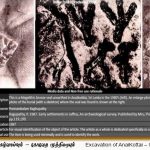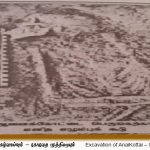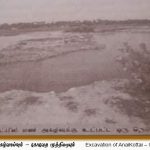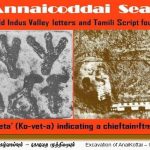

Excavation of AnaiKottai – Seal of Kovetham
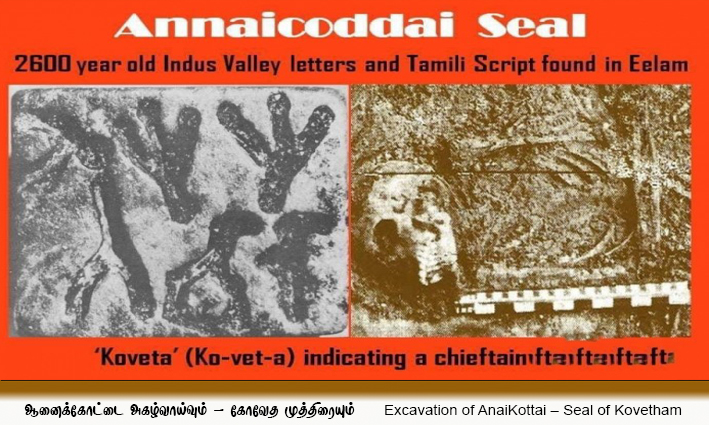
Anaikottai is a town located in Valikamam, Southwest Divisional Secretariat Division in the Gulf of Jaffna at the Northern Province of Sri Lanka.
Cultural remains found during excavations in the 1980s at Karaiyampity revealed the Nawanthurai area under the leadership of Professor Indira Bala. Six residential areas of two-square miles and large stone monuments had been identified within two acres.
During excavations carried out by Professor Indira Bala, emblems of Paleolithic people were found at two places. Two Urn (Eema) centers were found on a mound ten feet apart and four feet high at set intervals as well.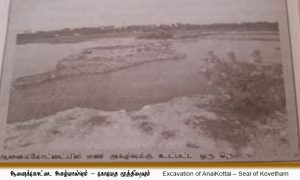
Two 5-foot-tall human skeletons were buried facing East and West. These skeletons’ hands were tied and surrounded with skeletal pottery in black and red, with separate black and red bowls, porringers, and pans. Some of the pottery contained fish and shark remains, animal bones, crab shells, as well as cones. Iron tools and scraps had been found to confirm the use of iron in the past.
Sculptures, conches, and shark bones reveal the artistic traditions of Sri Lanka’s prehistoric culture. At this time, the center of Anaikottai showed its close connections with the sea. The skeletons found here are second only to those in the Northern Province. The first place was found in Thiruketheeswaram by the late Mr. Shanmuganathan. This place was found during the excavations carried out by him.
The Brahmi-engraved pottery found at Anaikottai are based on Lakshmi coins and Roman pottery, which confirms that two urns with emblems belonged to these Paleolithic people dating back to 2,300 years ago.
The bronze seal found near the head of the skeleton is of great historical significance. It dates to the 3rd century BC and is 1.7 and 1.5 cm wide. It has 3 symbols in the top row and 3 Brahmi letters written in the bottom row. It is thought to be part of a ring front.
There have been many disagreements as to why this was done. Professor K. Indrapala had said in an article of the Tamil Hindu newspaper (1981) that this was a metal stamp, but he did not specify what metal it was made of. P. Iragupathi (1987) stated that the seal was made of bronze. Iravatham Mahadevan (2003) and Prof. c. Pathmanathan (2006) stated that although it is made of metal, they could not specify which metal it is made of or if it was an alloy.
In any case K. Indrapala wrote in a book in 2006 that it was made by Steatite (Soapstone). Indrapala’s book stated that it had three letters in the bottom line of a logo and a dot above the letter on the left as part of the Brahmi.
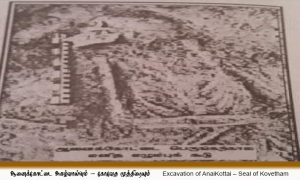
When viewed from the left, the first letter is “Ko”, the second “Veh”, and the third “Tha”. This is the print used for stamping so the space on the stamp will change to the right in alphabetical order and will be “Ko” “Veh” “Tha”. Indrapala says that the word can be read in two ways: “Koventha ” or “Kovethan” if we annuciate the dot above “Tha”.
Thiravida names have the same meaning. “Koventha” can be divided into two as “Ko” + “Ventha”. Both parts mean Raja and king in Tamil and some other Thiravidian languages. The upper bouts form a sula twice which makes it easier to access the higher frets.
These symbols are non-phonetic objects that are referred to as “ko” in the Sula form. It also refers to the word “ventha” or “vethan” which has the same meaning. Ragupathi interpretates these words a little differently.
Ragupathi read Indrapala’s description and read Brahmi as part of his first point. He said that the bottom lines “Ko”, “Veh”, and “Tha” is divided into “Ko” + “Ved” + “A” and gives the meaning of “Kovethan’s” which two form the sula syllables that parallel “Ko” “Veth”, with a dot “A” that means period. Mathivanan read the Brahmi region from left to right as seen on the seal as “Thi” “Vu” “Ko”, which means King of the Island.
The Keezhadi are 300 years older than the Anaikottai kings. The owners of Karaiyampitiy are Tamil natives who has been proven to be 2600 years old in 1984. A reminder of these forgotten people. Gerard, also known as Aanaiuran, mentioned Anaikottai as one of the stone ages centers.
The article further states that the Anaikottai seal represents a prehistoric period in which cultural life originated in the Paleolithic, Medieval and Neolithic periods, respectively. This period is known as the Stone Age because of the erected large stones and urns used to bury the dead. These symbols were part of stone culture.
However, the people of this period did not build their tomb emblems entirely of stone. They buried the dead in the tombs and pits. The Great Stone Age history of these tombs is told in Manimegala, one of the five Literatures.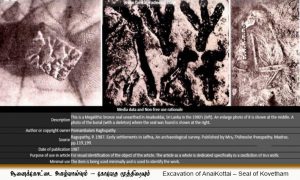
When we look at traces left by these ancient people, the evidence helps us understand them well. We find objects such as tombs, urns, boulders, sporting goods, pottery, weapons, rock paintings, jewelry, bells, seals, etc. Consumption appears to be seen as part of this structured society. Highlights of the Paleolithic culture include the introduction of iron, irrigated cultivation, and the use of black and red pottery as a structured social phenomenon.
Evidence has been found that this Paleolithic culture in Sri Lanka spread not only from South India but also from Southeast Asia. Paleolithic culture can be traced back between the year 1000 BC to 4th century BC.
The earliest appearance of antiquity in Sri Lanka has been found at Anuradhapuram and Sigiriya Aligala, dating to 1000 BC to 800 BC as confirmed by carbon dating.
The artistic traditions of the Paleolithic people of Sri Lanka are unique even though they are associated with the Paleolithic culture of South India.
For example, Urn towers made of coral stones, oyster shells, shark thorn garlands, etc. are unique to the people Paleolithic people of Sri Lanka. The range of Paleolithic cultural centers of Sri Lanka is found from the North to the South.
More than twenty Paleolithic cultural centers have been found in Sri Lanka. Endemic to Karainagar, Anaikottai, Kantharodai, Vallipuram, Poonakary, Maanthai, Thekkam, Pomparippu, Akkurugoda, Anuradhapuram, Kathiirgamam, Ibankattuwai and Hambantotai.
The Paleolithic cultural centers in Jaffna Bay are divided into two major sections, says Professor Raghupathi.
Anaikottai and Karainagar were the centers for the development of the Stone Age culture
(Before the arrival of Buddhism) which was rooted in the absence of any Buddhist influence. Anaikottai is one of the important archeological sites of northern Sri Lanka among the Paleolithic cultural sites associated with Buddhism.
In forty Heritage Centers across the Peninsula in the 1980s, Professor. P. Iragupati mentions Kantharodai as its chief residence.
These settlements have not been found in the Kantharodai, which is an urn symbol of culture in this Great Age. In this case, the discovery of Anaikottai. Anaikottai is important to the study of indigenous history.
